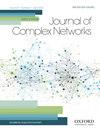The GNAR-edge model: a network autoregressive model for networks with time-varying edge weights
IF 1.5
4区 数学
Q2 MATHEMATICS, INTERDISCIPLINARY APPLICATIONS
引用次数: 1
Abstract
Abstract In economic and financial applications, there is often the need for analysing multivariate time series, comprising of time series for a range of quantities. In some applications, such complex systems can be associated with some underlying network describing pairwise relationships among the quantities. Accounting for the underlying network structure for the analysis of this type of multivariate time series is required for assessing estimation error and can be particularly informative for forecasting. Our work is motivated by a dataset consisting of time series of industry-to-industry transactions. In this example, pairwise relationships between Standard Industrial Classification (SIC) codes can be represented using a network, with SIC codes as nodes and pairwise transactions between SIC codes as edges, while the observed time series of the amounts of the transactions for each pair of SIC codes can be regarded as time-varying weights on the edges. Inspired by Knight et al. (2020, J. Stat. Softw., 96, 1–36), we introduce the GNAR-edge model which allows modelling of multiple time series utilizing the network structure, assuming that each edge weight depends not only on its past values, but also on past values of its neighbouring edges, for a range of neighbourhood stages. The method is validated through simulations. Results from the implementation of the GNAR-edge model on the real industry-to-industry data show good fitting and predictive performance of the model. The predictive performance is improved when sparsifying the network using a lead–lag analysis and thresholding edges according to a lead–lag score.gnar -边缘模型:一种用于边权时变网络的自回归模型
在经济和金融应用中,经常需要分析多元时间序列,它由一系列数量的时间序列组成。在某些应用中,这样的复杂系统可以与一些描述量之间成对关系的底层网络相关联。对这种类型的多变量时间序列分析的潜在网络结构进行核算是评估估计误差所必需的,对于预测来说尤其有用。我们的工作是由一个由行业对行业交易的时间序列组成的数据集驱动的。在这个例子中,标准工业分类(SIC)码之间的两两关系可以用一个网络来表示,SIC码作为节点,SIC码之间的两两交易作为边,而观察到的每对SIC码的交易数量的时间序列可以看作是边上的时变权重。受Knight et al. (2020, J. Stat. software .)启发。, 96, 1-36),我们引入了gnar边缘模型,该模型允许利用网络结构建模多个时间序列,假设每个边缘的权重不仅取决于其过去的值,而且取决于其相邻边缘的过去值,对于一系列邻近阶段。通过仿真验证了该方法的有效性。将gnar边缘模型应用于实际行业数据的结果表明,该模型具有良好的拟合和预测性能。利用超前滞后分析对网络进行稀疏化,并根据超前滞后评分对边缘进行阈值化,提高了预测性能。
本文章由计算机程序翻译,如有差异,请以英文原文为准。
求助全文
约1分钟内获得全文
求助全文
来源期刊

Journal of complex networks
MATHEMATICS, INTERDISCIPLINARY APPLICATIONS-
CiteScore
4.20
自引率
9.50%
发文量
40
期刊介绍:
Journal of Complex Networks publishes original articles and reviews with a significant contribution to the analysis and understanding of complex networks and its applications in diverse fields. Complex networks are loosely defined as networks with nontrivial topology and dynamics, which appear as the skeletons of complex systems in the real-world. The journal covers everything from the basic mathematical, physical and computational principles needed for studying complex networks to their applications leading to predictive models in molecular, biological, ecological, informational, engineering, social, technological and other systems. It includes, but is not limited to, the following topics: - Mathematical and numerical analysis of networks - Network theory and computer sciences - Structural analysis of networks - Dynamics on networks - Physical models on networks - Networks and epidemiology - Social, socio-economic and political networks - Ecological networks - Technological and infrastructural networks - Brain and tissue networks - Biological and molecular networks - Spatial networks - Techno-social networks i.e. online social networks, social networking sites, social media - Other applications of networks - Evolving networks - Multilayer networks - Game theory on networks - Biomedicine related networks - Animal social networks - Climate networks - Cognitive, language and informational network
 求助内容:
求助内容: 应助结果提醒方式:
应助结果提醒方式:


